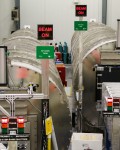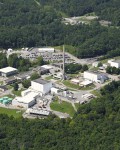Ionic liquids have emerged as promising new solvents capable of disrupting the cellulose crystalline structure, possibly also breaking important chemical linkages, in a wide range of biomass feedstocks. Such biomass is of significant future importance for providing fuels and chemicals.
Biomass has a complex mixture of cellulose, hemicellulose, and lignin that is difficult to break down and requires pretreatment for efficient conversion. Researchers pretreated four different feedstocks with an ionic liquid at high temperatures for a fixed time and compared the effectiveness on each sample. The four were microcrystalline cellulose (commercial Avicel), switchgrass, pine, and eucalyptus. They used the ionic liquid 1-ethyl-3-methylimidazolium acetate ([C2mim][OAc]) and treated the samples at 120 and 160°C for 1, 3, 6, and 12 hours. An antisolvent was added to the solution to recover the biomass after pretreatment.
The impact of the pretreatment on the cellulose crystalline structure was analyzed by x-ray diffraction. The impact on the surface roughness was determined by small-angle neutron scattering (SANS) at the General-Purpose SANS instrument at Oak Ridge National Laboratory’s High Flux Isotope Reactor. The two techniques reveal complementary information that will help more fully elucidate the process of ionic liquid pretreatment, especially the efficiency of reducing biomass to a liquid state (enzymatic hydrolysis).
Research has shown that pretreatment by ionic liquids typically results in a decrease in the crystallinity of cellulose. The native crystal structure, or cellulose I, is changed by pretreatment to cellulose II that is more readily digested. For switchgrass, first evidence of cellulose II occurred after 12 hours of pretreatment at 120°C. For eucalyptus, first evidence of cellulose II required more intense pretreatment (3 hours at 160°C). For pine, no clear evidence of cellulose II content was detected for the most intense pretreatment conditions of the study (12 hours at 160°C).
SANS was used to investigate the effect of the ionic liquid pretreatment on the surface roughness of the samples. Neutron scattering is nondestructive and more penetrating to most solid materials than x-ray scattering, which allows better characterization of the internal structure of dense, porous materials.
X-ray diffraction showed changes in the structure of the crystalline domains on the length scale of angstroms (Å, i.e., tenths of a billionth of a meter), and SANS measured the surface roughness at 10 to 1000 Å. The neutron diffraction patterns show the pathway by which the transition in the crystal structure occurs. For switchgrass, the alignment of the chains into microfibrils was eliminated after ionic liquid pretreatment at 120°C for 6 hours. From that point on, the cellulose starts to possess increasing cellulose II content. A more severe pretreatment was required for eucalyptus to reach that stage, and pine required the most severe pretreatment.
Such variation of the surface roughness of recovered biomass samples after pretreatment suggests, as has been demonstrated by others, the presence of lignin-carbohydrate complexes that resist breakdown and are degraded more efficiently at higher temperature. The trend in the rate of hydrolysis for the four samples correlates with the conversion rates from cellulose I to cellulose II.
The researchers found:
- For Avicel, a transformation to cellulose II occurred for all processing conditions. For the biomass samples, the data suggest that pretreatment for most conditions resulted in expanded cellulose I lattice.
- For switchgrass, first evidence of cellulose II occurred only after 12 hours of pretreatment at 120°C.
- For eucalyptus, first evidence of cellulose II required more intense pretreatment (3 hours at 160°C).
- For pine, no clear evidence of cellulose II content was detected for the most intense pretreatment conditions of this study (12 hours at 160°C).
Pretreatment of the biomass samples at 160°C greatly facilitated enzymatic hydrolysis, compared with pretreatment at 120°C. Combined with the results for Avicel, this confirms the importance of another factor, likely lignin-carbohydrate complexes, to the rate that biomass is reduced to liquid form.
SANS showed that among the biomass samples, switchgrass possessed much rougher internal surfaces, showed more rapid conversion to cellulose II, and showed substantially more rapid hydrolysis after pretreatment at 120°C than did pine. Results for eucalyptus fell in between but were closer to those for switchgrass. These observations could be explained by less extensive lignin intermixed with the cellulose microfibrils for switchgrass than for pine, although at present, the researchers have no direct evidence of that.
Funding:
This work was part of the DOE Joint BioEnergy Institute supported by the U.S. Department of Energy, Office of Science, Office of Biological and Environmental Research, through contract DE-AC02- 05CH11231 between Lawrence Berkeley National Laboratory and the U.S. Department of Energy. Research at HFIR at ORNL was sponsored by the Scientific User Facilities Division, Office of Basic Energy Sciences, U.S. Department of Energy. Principal investigator G. Cheng would like to acknowledge the EPSCoR Neutron Travel Fellowship through the University of Tennessee.
Published Work:
Cheng, G., Varanasi, P., Li, C., Liu, H., Melnichenko, Y. B., Kent, M., Simmons, B., and Singh, S., “Understanding Cellulose: Controlling Crystal Structure and Saccharification Kinetics via Ionic Liquid Processing,” Biomacromolecules 12 (4), 933-941 (2011).




